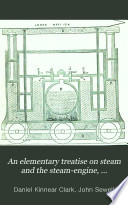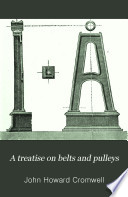 | William Somerville Orr - Science - 1860 - 540 pages
...ooUUU The complete rule for finding the power may therefore be thus stated : — Measure the ordinales (at least 6 or 8 in number) contained within the indicator...of 4 feet, and making 27 revolutions per minute, 8 ordinales of the figure were found to be respectively 34, 34, 34, 33, 24, 18, 14, and 9 : required... | |
 | John Bourne (C. E.) - Steam engineering - 1868 - 602 pages
...VELOCITY WITH WHICH A BODY REVOLVES IN A CIRCLE. RULE. — Multiply the diameter of the circle in feet by the number of revolutions per minute, and divide the product by the constant number 153-2. The square of the quotient is the height, in feet, due to the velocity with... | |
 | Daniel Kinnear Clark - 1885 - 374 pages
...stroke by multiplying the area of the piston in square inches by the effective mean pressure in pounds per square inch, by twice the length of stroke in feet, and by the number of turns of the crankshaft in a minute. The whole process is compactly given by either of the following... | |
 | Daniel Kinnear Clark - Steam - 1885 - 424 pages
...stroke by multiplying the area of the piston in square inches by the effective mean pressure in pounds per square inch, by twice the length of stroke in feet, and by the number of turns of the crankshaft in a minute. The whole process is compactly given by either of the following... | |
 | John Howard Cromwell - Belts and belting - 1885 - 302 pages
...determine the velocity of a pulley in feet per second, multiply by the circumference of the pulley in feet by the number of revolutions per minute, and divide the product by 60; or multiply 0.1047 times the radius in feet by the number of revolutions per minute. By transposing... | |
 | Walter S. Hutton - 1885 - 486 pages
...by a modification of Murray's Rule, thus : multiply the cube of the diameter of the shaft in inches by the number of revolutions per minute, and divide the product by 1 70 for wrought-iron, or by 260 for cast-iron, or by 85 for steel. To find the diameter of a shaft... | |
 | John Howard Cromwell - Belts and belting - 1885 - 302 pages
...determine the velocity of a pulley in feet per minute, multiply the circumference of the pulley in indies by the number of revolutions per minute, and divide the product by 12, or multiply 0.5236 times the radius in inches by the number of revolutions per minute. Let v represent... | |
 | Daniel Kinnear Clark - Steam - 1892 - 440 pages
...stroke by multiplying the area of the piston in square inches by the effective mean pressure in pounds per square inch, by twice the length of stroke in feet, and by the number of turns of the crankshaft in a minute. The whole process is compactly given by either of the following... | |
 | Daniel Kinnear Clark - Mechanical engineering - 1892 - 682 pages
...effective mean pressure oil the piston m pounds per square inch, and. by twice the length of the stroke, and by the number of revolutions per minute ; and divide the product by 33,000. The quotient is the indicator horse-power. For compound and multiple-expansion engines, the... | |
 | Hermann Haeder - Steam-engines - 1893 - 468 pages
...pressure, which multiplied by -1 **-*' * *° *' *< ^ the area of the piston in square inches by twice the stroke in feet, and by the number of revolutions per minute, and divided by 33,000, gives the indicated horse-power. If diagrams be taken with a load on the engine... | |
| |